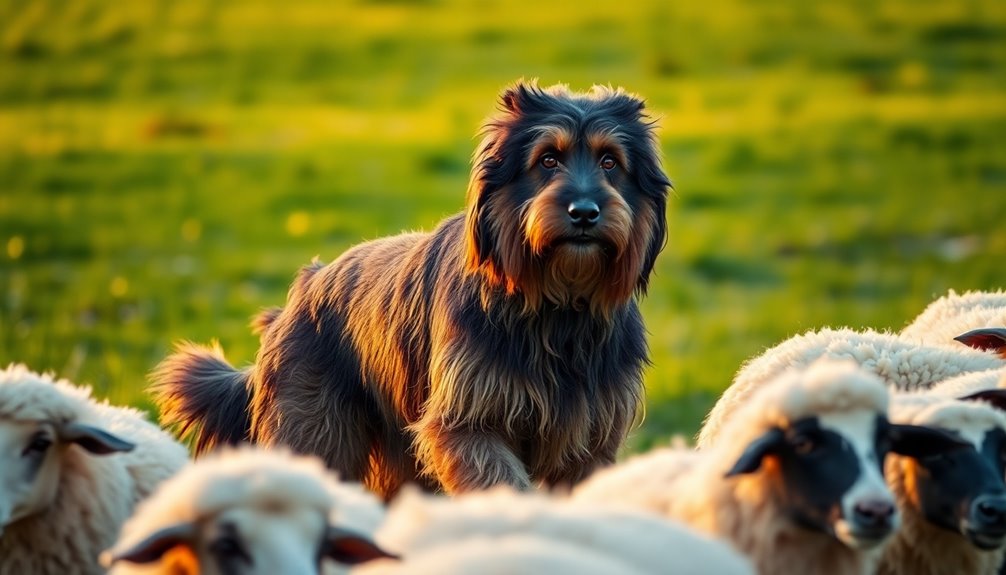The Briard is a loyal French herding dog, known for its intelligence and protective nature. Weighing between 50 to 100 pounds, these dogs feature a distinctive double coat and a strong, muscular build. They thrive in spacious environments and need daily exercise to keep them happy and healthy. With a history dating back to the 8th century, Briards have served as reliable herders and guardians. Their gentle demeanor makes them great companions for families, especially with children. If you're curious about their training needs and living requirements, there's much more to discover about this fascinating breed.
Key Takeaways
- The Briard is a loyal herding dog known for its intelligence and strong protective instincts.
- Originating in 8th century France, the Briard has a rich history as a herding and guard dog.
- This breed requires daily exercise and mental stimulation, thriving in active environments with ample outdoor space.
- Briards have a long, double coat that requires daily grooming to prevent matting and maintain health.
- They are generally good with children and excel in family settings, though their herding instincts may emerge.
Introduction

The Briard is a remarkable herding dog known for its loyalty and intelligence. Weighing between 50 to 100 pounds, these dogs stand tall, with males reaching up to 26 inches and females at 24 inches. Their long, double coat consists of a coarse outer layer and a soft, dense undercoat, available in various colors excluding white, such as black, gray, and tawny.
You'll notice their naturally floppy ears, which can be left as is or cropped.
Briards possess a highly independent nature, so you'll need to establish consistent training to ensure they respect your commands. Their loyalty to family is unmatched, but they may be wary of strangers. They thrive on socialization and can live harmoniously with other pets, provided they're properly introduced. Additionally, their high energy level means they excel in active environments where they can engage in herding and outdoor activities.
Keep in mind that these energetic dogs require more than 40 minutes of exercise daily. Regular physical activity prevents boredom, which can lead to destructive behavior.
With high grooming needs and a preference for spacious living, the Briard is perfect for active families who can provide the attention and environment they deserve.
History and Origin

The Briard's roots trace back to 8th century France, where it was developed from various European sheepdogs. You'll find that these dogs weren't only herders but also loyal guardians, protecting livestock and estates. Their historical significance as protectors makes them an invaluable part of agricultural life in France. The breed's first appearance was recorded in Paris at the 1863 dog exposition, highlighting its early recognition and value.
Where and when the breed originated
Originating in the picturesque Brie region of north-central France, the Briard breed boasts a rich history that dates back to the 8th century. This area, closely associated with the French dairy belt, served as the perfect backdrop for the development of these remarkable herding dogs.
You'll find the first written mention of the Briard in the 14th century, but its prominence truly surged during the Middle Ages as a reliable herding and guard dog.
The breed is thought to have evolved from various European sheepdogs, possibly including the Barbet and the Beauceron. In 1783, Jean-Baptiste François Rozier highlighted the Briard in his *Cours complet d'agriculture*, showcasing its agricultural significance. Health studies indicate the average life expectancy of Briards is about 12.6 years, which reflects their well-being as a breed.
The breed made its debut at the first Paris dog show in 1863, and by 1885, it was officially registered in the *Livre des Origines Françaises*.
The breed standard was established in 1897, with two coat varieties recognized. The Briard's journey continued internationally when Thomas Jefferson introduced it to the United States in the late 1780s, where it quickly adapted as both a family companion and a working dog.
Livestock Guardian and Protector
Briards have long been known as exceptional livestock guardians and protectors, developed specifically to herd and safeguard flocks of sheep. In the Middle Ages, these dogs served as all-around farm helpers, aiding shepherds with various tasks while protecting estates from potential threats. Their strong work ethic and protective nature made them invaluable, especially in the mountainous summer pastures where they moved and guarded sheep.
During both World Wars, Briards showcased their versatility by serving as messenger, sentry, and search-and-rescue dogs. They worked with medical corps to locate wounded soldiers, demonstrating an uncanny ability to distinguish between those who could be helped and those who couldn't. These contributions, however, led to significant losses that affected the breed's numbers.
Today, Briards continue to excel in herding and guarding roles. They possess extremely sensitive hearing, making them effective sentries. With their unique double dewclaws enhancing mobility, they can act as living fences, keeping flocks contained. Additionally, their high guarding instincts ensure that they remain vigilant protectors of both livestock and family.
To thrive, they require regular mental and physical stimulation, along with companionship that involves them in family activities. Their fearless yet gentle nature ensures they remain exceptional protectors of livestock.
Physical Characteristics

When you look at a Briard, you can't help but notice their impressive size and sturdy build, with males standing 24 to 27 inches tall. Their long, flowing double coat adds to their distinctive appearance, coming in various shades like black and tawny. This combination of size and coat makes them truly stand out among herding breeds. Additionally, the Briard has a strong, muscular build that is ideal for herding tasks, showcasing their versatility and athleticism.
Size, weight, and coat details
The Briard stands out among dog breeds, with males typically reaching heights of 23 to 27 inches and females ranging from 22 to 25.5 inches at the shoulder. By the time they hit six months, male puppies usually stand about 21-23 inches tall, while females are around 18-21 inches. Growth continues until they're about one year old, with males reaching 23-26 inches and females hitting 21-24 inches.
In terms of weight, males typically weigh between 70 to 90 pounds, while females range from 50 to 70 pounds. At three months, male puppies weigh around 30-35 pounds, and females are about 25-30 pounds. By adulthood, males usually weigh between 27 to 41 kg, and females weigh 23 to 34 kg, with males being roughly 8.8 pounds heavier. Rapid growth occurs in the first six months, which is crucial for their overall development.
Briards grow rapidly in their first six months, with growth slowing down as they approach their first birthday. Their growth is usually complete by 19 months.
With a strong and rectangular head, a well-proportioned body, and muscular limbs, the Briard's physical characteristics truly exemplify their robust nature.
Long, Flowing Double Coat
With their impressive size and sturdy build, Briards are equally known for their striking long, flowing double coat. This unique coat consists of a harsh, goat-like outer layer that's coarse and dry, providing excellent resistance against the elements. Beneath it lies a soft, dense undercoat that ensures warmth and comfort. The Briard's coat is a grooming challenge due to the potential for matting if the undercoat is not maintained properly.
The outer coat can reach lengths of 6-18 inches, giving the Briard a regal appearance as it flows gracefully during movement. When you touch the coat, you'll notice a distinct rasping sound, indicating its texture. The colors vary from solid black, gray, and tawny to combinations of these, with tawny shades ranging from almost white to deep reddish tan.
While white markings are generally not acceptable, small white spots on the chest can be common, and black masking on the ears, beard, and tail adds to their charm.
Maintaining this stunning coat requires commitment; daily brushing is essential to prevent matting, particularly in areas prone to tangling. Occasional baths and regular grooming will keep your Briard looking its best while ensuring their skin remains healthy.
Temperament and Personality

When you think of a Briard, imagine a dog that's not only protective but also incredibly intelligent. Their loyal nature makes them a great fit for families, individuals, and even other pets, as they bond deeply and exhibit a gentle demeanor. With the right training and socialization, these dogs can thrive in a variety of environments, making them versatile companions. Their high-energy level means they require substantial mental and physical stimulation to remain happy and healthy.
Protective and Intelligent Nature
Briards possess a unique blend of protective instincts and intelligence that makes them exceptional companions and guardians. With their strong ancestral urge to guard, they excel as watchdogs, alerting you to strangers and potential threats. While they may seem defensive and territorial, especially in familiar spaces, they're not typically aggressive without cause. They might be wary of newcomers and require proper introductions to feel comfortable.
Their independent nature is rooted in their herding background, giving them a self-assured confidence. This can lead to stubbornness, so consistent training is essential. Positive reinforcement works best to manage their independent tendencies, and although they can handle some alone time, they truly value companionship. Briards were originally bred to protect flocks from wolves, which contributes to their vigilant demeanor. Additionally, they thrive when owners apply growth mindset principles, viewing challenges in training as opportunities for improvement.
Briards are highly intelligent and quick problem-solvers, thriving on mental challenges. They respond well to training, but you'll need to establish clear leadership through ongoing exercise and mental stimulation.
Their loyalty and affection are remarkable; they form strong bonds with family, often described as "gentle giants." They love to please and need kindness, as harsh treatment can impact their well-being. In return for your love, they'll offer unwavering loyalty and joy in your life.
Suitability for families, individuals, or other pets
Finding the right dog for your family or lifestyle can be challenging, but Briards often prove to be a great match. They're generally good with children, thanks to their gentle and patient nature. However, you'll need to manage their herding instincts, as they might try to herd your kids. Training commands like "leave it" or "watch me" can help keep their behavior in check. Early socialization is key to ensuring they interact well with family members.
For individuals, Briards can adapt well, as their independent nature allows them to spend time alone. They do require consistent training and mental stimulation, so be prepared for regular exercise to avoid boredom. While they can be stubborn, strong leadership fosters loyalty and companionship. Additionally, their high intelligence means they can excel in various dog sports and activities, making them a fun and engaging companion.
If you have other pets, Briards can coexist harmoniously if raised together and properly socialized. Just be aware of their high prey drive, which might lead them to chase smaller animals. Supervision and training are essential to prevent undesirable behavior.
Health and Lifespan

When you bring a Briard into your home, it's crucial to be aware of their typical lifespan of 10 to 12 years and the common health concerns they may face. Issues like hip dysplasia and bloat can affect their quality of life, so staying proactive about their health is essential. Regular check-ups and maintaining a healthy weight can help ensure your Briard thrives for years to come. Additionally, proper nutrition plays a significant role in preventing these health issues and supporting their overall well-being.
Typical lifespan of the breed
On average, the lifespan of a Briard typically ranges from 10 to 12 years, but with proper care, many can live beyond that. To help your Briard thrive, focus on regular veterinary check-ups and a balanced diet rich in protein and healthy fats. Maintaining optimal nutrition is crucial for their longevity.
Regular exercise plays a significant role in keeping your Briard healthy and happy. Ensure they get plenty of physical activity to avoid obesity and encourage mental stimulation through engaging activities. Fresh water should always be available, and be mindful of treat consumption to support a healthy weight. Briards are also known for their high exercise needs, which means they require long and engaging outdoor activities to stay fit.
Briards enjoy outdoor activities, but keep an eye on them in hot weather, as they may struggle with extreme heat. Regular grooming is essential to manage their long double coat, which can also contribute to their overall well-being.
By creating an environment that challenges both their mind and body, you can enhance their quality of life.
With a sturdy constitution, Briards are generally robust and healthy, but your commitment to their care and lifestyle will significantly impact their lifespan. Make each year count with love and attention!
Common health concerns or genetic predispositions
Briards, like many purebred dogs, can face specific health concerns and genetic predispositions that potential owners should be aware of.
One significant issue is hip dysplasia, an inherited condition causing improper hip joint formation, leading to arthritis. Symptoms often include lameness in the hind legs and difficulty getting up. Regular exercise is essential to maintain a healthy weight and reduce the risk of joint problems.
Elbow dysplasia also poses a risk, causing joint pain and mobility challenges.
Eye problems are another concern. Progressive Retinal Atrophy (PRA) can lead to blindness, typically manifesting between 3-5 years of age. Other conditions include corneal dystrophy and congenital stationary night blindness, which can affect your Briard's vision significantly.
Metabolic issues, such as hypothyroidism, can result in dry skin and weight gain, making annual blood screenings crucial.
Additionally, Briards may face digestive problems, including exocrine pancreatic insufficiency.
Lastly, be vigilant about parasites and the risk of bloat, a life-threatening condition.
Regular veterinary check-ups and genetic testing can help identify some of these concerns early, allowing you to take proactive steps to maintain your Briard's health.
Tips for maintaining health and wellness
Maintaining your Briard's health and wellness is crucial for ensuring a long, happy life. Start with a balanced diet rich in proteins, fats, carbohydrates, vitamins, and minerals. Opt for high-quality dog food specifically designed for active breeds. Incorporate omega fatty acids to enhance your Briard's coat health, and remember to moderate treat giving—treats shouldn't replace main meals. Including turmeric's anti-inflammatory properties in their diet can also support joint health.
If considering a raw food diet, include meat, bone, offal, and small amounts of plant ingredients for optimal nutrition.
Regular exercise is essential. Daily walks and play sessions keep your Briard healthy and happy while preventing joint issues and maintaining a healthy weight. Mental stimulation through training or interactive toys is equally important, given their high energy levels. Always use a leash outdoors, as they've a strong prey drive, reflecting their protective nature.
Grooming is vital too. Brush your Briard daily or at least three times a week to prevent coat knotting. Bathe every 15 days to control shedding. Pay special attention to ear and eye hygiene, and ensure you clean their beard after meals.
Lastly, schedule regular vet check-ups, dental care, and monitor their diet to keep them thriving.
Care Requirements

Caring for a Briard means committing to regular brushing to keep their long coat healthy and tangle-free. Regular brushing promotes coat health and reduces breakage, ensuring their beautiful coat stays in top condition. You'll also need to ensure they get over 40 minutes of exercise daily to match their high energy levels. Additionally, paying attention to their diet with high-quality food and proper feeding schedules will help maintain their overall health.
Regular Brushing Required
Regular brushing is essential for keeping your Briard's coat in top condition and preventing matting. You should aim to brush your Briard daily, especially during the transition from puppy to adult coat, which can lead to increased tangling. Though it might be time-consuming, this routine is crucial for maintaining your dog's coat health and appearance. If neglected, serious matting issues can develop. Regular grooming also promotes comfort and reassurance for the dog, making the grooming process more enjoyable for both the pet and the owner.
For grooming, a wire pin brush or a slicker brush works well. Consider using the "line brushing" method, which involves brushing the coat in sections to effectively manage tangles. A spray bottle with water or a detangling spray can help prevent hair breakage, making the process smoother.
Don't forget to comb out the excess undercoat, especially around the ears, neck, and tail; a grooming rake can assist with this.
While your Briard doesn't require frequent bathing, regular brushing will keep the coat clean. You may also want to trim the hair around the feet and between the eyes for better visibility.
Exercise requirements and energy levels
Grooming your Briard goes hand in hand with meeting their exercise needs, which are vital for their overall well-being. Daily exercise is essential for keeping your Briard healthy and happy. Aim for about 30 to 45 minutes of activity each day, incorporating daily walks, play sessions, and mental stimulation.
High-intensity activities like biking, hiking, and running work wonders to fulfill their physical needs. A safe space for them to run and romp is crucial, especially if you live in a small house.
Briards have a balanced to medium-high energy level, reflecting their herding origins. They're quick, agile, and ready to go when you encourage them, but they can also chill out for hours. This means you need to commit to providing adequate physical and mental activities to keep them engaged. Additionally, their protective instincts may lead to herding behavior, especially with children, so it's important to manage their interactions during play.
Mental stimulation is just as critical; consider activities like nose work, hide-and-seek, or fetch. Short, fun training sessions with basic commands or interactive toys can also help channel their energy and prevent boredom. If you can meet these exercise and stimulation needs, your Briard will thrive!
Feeding tips and diet recommendations
Feeding your Briard properly is crucial for their health and vitality. Focus on high-quality proteins from animal sources like beef, chicken, and fish, as these are essential for muscle maintenance. Incorporate essential fatty acids and omegas for optimal health, and add small amounts of carbohydrates from vegetables and berries. It's important to keep in mind the herding instincts of Briards, which can influence their energy levels and dietary needs.
Make sure to provide hydration through high-moisture foods and plenty of fresh water. For adult Briards, aim for at least two meals a day, while puppies may need three due to their higher metabolism. It's best to serve smaller portions to reduce the risk of bloat.
Adjust meal frequency and portion sizes based on your dog's age, weight, and activity level. Treats shouldn't exceed 10% of their daily calorie intake. Always choose AAFCO-compliant foods that are nutritionally complete.
If considering a raw food diet, consult your vet first. Monitor your Briard's weight and adjust their caloric intake as necessary. Regularly review their diet plan to ensure it meets their individual needs, and consider natural supplements to support their health without replacing a balanced diet.
Training and Socialization

When training your Briard, you'll find they're moderately responsive to commands, so patience is essential. Gradually exposing them to new environments helps build their confidence and reduces leash aggression towards strangers. Additionally, understanding their natural herding instincts can enhance training effectiveness and provide a productive outlet for their energy.
Moderately Responsive to Commands
One might find that Briards are moderately responsive to commands, largely due to their intelligent yet independent nature. To train your Briard effectively, use a firm yet gentle approach. Consistent training with positive reinforcement methods is key—harsh words and forceful measures can backfire. Proper training not only enhances obedience but also supports their emotional regulation, promoting a balanced temperament.
Since Briards excel in various roles and sports, keep training sessions lively and engaging to maintain their interest. Start early with socialization and obedience training, as this lays the groundwork for good behavior throughout their lives. Briards were historically the official war dog of the French army during WWI, showcasing their versatility and loyalty.
Briards need exposure to new people, environments, and situations to foster positive social interactions. Remember, they can be selective with strangers, so clear and consistent leadership is essential.
With a strong memory and quick learning abilities, your Briard will thrive in a structured environment. However, be patient and adaptable, especially as they mature; they mightn't always follow commands unless they see the benefit.
Reward-based training is particularly effective in encouraging desired behaviors. By prioritizing these training methods, you'll ensure your Briard develops into a well-behaved and happy companion, blending their protective instincts with positive social behavior.
Gradual Exposure to New Environments
Gradual exposure to new environments plays a vital role in a Briard's training and socialization. Start with familiar settings like your home and backyard to help your puppy feel secure while introducing minor changes. Add new toys or blankets to gently acclimate them to change without overwhelming. As an intelligent and loyal breed, Briards often thrive when they have a strong sense of security during these transitions.
Leash Aggression Towards Strangers
Leash aggression towards strangers can be a frustrating challenge for both you and your Briard. This behavior often stems from fear, frustration, or a protective instinct, causing your dog to react aggressively while restrained. When your Briard can't get closer or move away from a perceived threat, stress levels can rise, leading to barking, lunging, or growling.
To manage this issue, start with proper training and socialization. Set your dog up for success by avoiding situations that trigger aggression. Use positive reinforcement to teach your Briard to focus on you instead of potential threats.
Implement games like "Engage/Disengage," where your dog learns to look at you when encountering distractions. Walking during off-peak times or in quieter areas can also reduce encounters that provoke aggressive reactions.
Remember to practice good leash handling techniques and consider emergency maneuvers, like U-turns, to redirect your dog's attention. Leashes act as barriers, which can increase stress levels in dogs, making it essential to manage their environment carefully. Muzzle training can provide an extra layer of security while you work on these behaviors.
With patience and consistent training, you can help your Briard feel more comfortable and less reactive, ensuring enjoyable outings for both of you.
Ideal Living Environment

If you're considering a Briard, you'll want a house with ample outdoor space for them to run and play. These dogs thrive in cooler climates and can struggle in extreme heat, so keeping them comfortable is key. A large, fenced-in yard will help meet their exercise needs while providing a safe environment. Additionally, Briards require at least one hour of exercise daily to maintain their health and happiness.
House With Ample Outdoor Space
A spacious home with ample outdoor space is essential for a Briard's happiness and well-being. These energetic dogs thrive in environments where they can run and play freely. A large, fenced-in backyard is ideal, as it prevents them from roaming and allows them to sprint and stretch their legs safely.
Without adequate outdoor space, you'll need to commit to significant daily walks and exercise to meet their needs. Briards require at least 40 minutes of physical activity each day. Activities like hiking, herding, and long walks are perfect for burning off their high energy levels. Mental stimulation is equally important, as it helps prevent destructive behaviors like chewing and digging that can arise from inactivity. Additionally, since Briards are known for their high digging tendency, engaging them in activities that channel this behavior positively can be beneficial.
Since Briards prefer to be near their owners, having a yard means they can enjoy your company while playing outside. This is crucial for their social needs and emotional health.
Ultimately, providing a safe and spacious environment will lead to a happier, healthier Briard, ensuring they remain your loyal companion for years to come.
Prefers Cooler Climates Over Heat
When it comes to temperature preferences, Briards thrive in cooler climates, thanks to their thick double coat that provides excellent insulation against the cold. These dogs are naturally equipped to frolic in the snow and handle lower temperatures quite well. Additionally, their historical significance as herding dogs means they are well-suited for outdoor activities in cooler environments.
However, they become sensitive to extreme heat, so they need a cool, shaded environment during warmer months. It's important to avoid intense physical activity during peak sunshine hours, as their coat, while protective against cold, can make them uncomfortable in heat.
With their long, wavy double coat, Briards repel dirt and sand, reducing the need for frequent bathing. Regular grooming ensures their coat remains healthy and comfortable.
They require rigorous exercise to stay happy, so engaging in activities like fetch or tug-of-war is essential, especially in extreme weather conditions.
While they're tolerant of cold, you shouldn't leave them outdoors for extended periods. Always monitor their activity levels to prevent health issues.
Creating a cool environment in hot weather is vital for their comfort and well-being. By understanding their climate preferences, you can ensure your Briard leads a happy and healthy life.
Briards Excel in Herding Trials

When it comes to herding trials, Briards truly shine, thanks to their exceptional scent-tracking ability. You'll see them excel as they work seamlessly with their handlers, showcasing skills that are both impressive and essential in managing livestock. Teamwork between handler and dog is crucial for their success in these events. Plus, their unique charm even caught the attention of filmmakers, making them stars in French cinema.
Exceptional Scent-Tracking Ability
Exceptional scent-tracking ability defines the Briard's role in herding and protecting livestock. Unlike traditional herding dogs, Briards function primarily as boundary herders, using their keen sense of smell to manage and safeguard the flock. Their strong work ethic and intelligence play crucial roles in these tasks, allowing them to adapt to different environments and challenges. Interestingly, bloodhounds have been utilized in law enforcement for over 200 years, showcasing the impressive capabilities of scent-tracking dogs. Moreover, the ability to detect changes in odor can be vital for identifying the health of livestock.
While Briards may not be as specialized in scent-tracking as breeds like Bloodhounds or German Shepherds, their capabilities are still impressive. These dogs can follow complex scent trails, making them valuable in various roles, including search and rescue. Their versatility enables them to excel in obedience and agility, further enhancing their utility.
Training a Briard involves consistent, positive reinforcement, as their intelligence and problem-solving skills shine during the process. Though they require patient training due to their independent nature, the results are worth it.
Briards can be directed to focus on specific scents, which amplifies their effectiveness in herding and protective roles. In essence, their scent-tracking ability is an integral part of their broader skill set, essential for managing and safeguarding livestock.
Featured in French Films
While Briards aren't commonly featured in French films, their prowess in herding trials is well-documented and celebrated. You might notice that other French breeds, like the Berger Picard, often take center stage in cinematic portrayals. This absence of Briards in films doesn't diminish their historical significance; they've served as excellent herders and guardians for centuries.
Their herding methods are impressive, as they circle the flock, acting as a moving fence to control sheep. This instinctual behavior has made them highly respected in herding competitions, especially in the United States. With their quicksilver trot and independent spirit, Briards excel in various modern activities, showcasing their versatility beyond herding. Additionally, their strong protective instincts ensure they remain excellent watchdogs for families.
Although you won't find them in notable French films, Briards have played significant roles throughout history, including during both World Wars. Their loyalty and protective nature have made them invaluable companions for French farmers and families alike.
Active Lifestyle Compatibility

If you're looking for a family-friendly dog that can keep up with your active lifestyle, the Briard might just be your perfect match.
With their high energy levels and love for outdoor activities, they thrive in environments where they can run and play. The Briard's strong loyalty to their families makes them not only great companions but also protective guardians.
However, you'll need to commit time to grooming and training to ensure they stay happy and healthy.
Family-Friendly yet Active Companion
The Briard stands out as an ideal family companion for those who lead an active lifestyle. With their loving and protective nature, these dogs aren't just great pets but also devoted family members. If you have children, you'll find that Briards are exceptionally good with them, displaying patience and gentleness that make them kid-friendly. Their high affection level means they thrive on companionship, creating strong bonds with your family.
To keep a Briard happy and healthy, daily brisk exercise is essential. Aim for 30 to 45 minutes of activity, whether it's biking, hiking, or playing fetch. Engaging them in high-intensity activities is crucial for both their physical and mental stimulation. Incorporate interactive play, puzzle toys, and short, fun training sessions to keep their minds sharp and prevent boredom. Additionally, their high energy levels mean they require ample space to run and play.
These dogs do best in active households where they can run and romp freely. While they can adapt to various living situations, they aren't suited for apartment life due to their energy levels.
Grooming Demands and Time Commitment
Maintaining a Briard's beautiful coat requires a commitment to regular grooming, which can be seamlessly integrated into your active lifestyle. Ideally, you'll groom your Briard once or twice a week, but some may need daily brushing to prevent matting and tangling. The brushing technique is crucial; use the "line brushing" method with a slicker brush to minimize breakage. A quick daily brush will keep your dog's coat in top shape. Raking removes dead coat and undercoat, enhancing the overall health of your Briard's coat.
Though grooming can be time-consuming, it's manageable. You can easily fit in short grooming sessions around your active routine, whether you're biking, hiking, or running. Incorporate mental stimulation activities like nose work or fetch during grooming, making it a fun bonding time.
If you prefer to shorten grooming time, consider regular trims or even a shave for older dogs. This not only reduces grooming demands but also lessens the need for frequent baths.
Frequently Asked Questions
Do Briards Get Along With Other Pets?
If you're wondering whether Briards get along with other pets, the answer is generally yes, especially with proper socialization.
Introducing them to pets of the opposite sex can reduce conflicts. You'll want to supervise and manage their interactions, particularly since their herding instincts may kick in.
Early socialization and positive training can help maintain harmony in your household.
With the right approach, your Briard can thrive alongside other pets.
How Much Grooming Do Briards Require?
Briards require a lot of grooming to keep their coats healthy and free from mats. You should brush them multiple times a week, ideally daily, especially during the transition from puppy to adult coat.
Some may even need daily grooming to manage matting. Using tools like wire pin brushes and slicker brushes can help.
Regular grooming also reduces the need for frequent baths and keeps their coat clean and looking great.
Are Briards Good Family Dogs?
Yes, Briards can be great family dogs! They're people-oriented and love to please, making them loyal companions.
You'll find that they thrive on human interaction and often follow you around the house. With proper training and socialization, they can be wonderful with kids, although their high energy may be overwhelming for very young ones.
Just remember, they need plenty of exercise and mental stimulation to keep them happy and well-adjusted in a family setting.
What Is the Average Lifespan of a Briard?
The average lifespan of a Briard is typically around 12 years, but it can range from 10 to 12 years.
You can help extend their lifespan through proper care, regular check-ups, and a balanced diet.
Consistent exercise is crucial, as it keeps them healthy and active.
Can Briards Be Left Alone for Long Periods?
You shouldn't leave Briards alone for long periods. They thrive on human interaction and can experience separation anxiety, leading to destructive behaviors.
Ideally, limit their alone time to 6-8 hours, but they often need more frequent breaks. Consider alternatives like doggy daycare or a dog walker to keep them company.
Providing engaging toys or puzzles can also help keep them occupied while you're away, ensuring their emotional well-being remains intact.
Conclusion
In conclusion, the Briard is a remarkable breed known for its loyalty and intelligence. Whether you're looking for a devoted companion or a skilled herding partner, this dog fits the bill. With proper training and socialization, you'll enjoy a fulfilling bond with your Briard. If you lead an active lifestyle, this breed will thrive alongside you, making your adventures even more special. Embrace the unique qualities of the Briard, and you'll have a friend for life.










